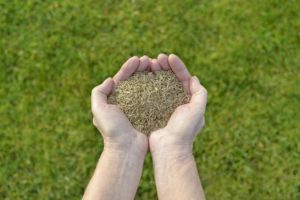
What Exactly is Overseeding?
To overseed your lawn, you will seed on top of your existing lawn. In time, you will begin to notice a change in your lawn. As your lawn ages, there is a decrease in the rate at which new grass blades grow. As the grass weakens, weeds may begin to take over. Your lawn needs overseeding when it has become brown, thin, and patchy. Warm-season grass becomes dormant during the winter so many people opt to overseed with a cool-season grass seed so that their lawn experiences growth all year.
When Should I Overseed My Lawn?
The timing is based upon the type of seeds you will be planting. Plan to overseed your lawn 45 days prior to the planting zone’s first frost in the fall. This can help strengthen a weak or thinning lawn. In the Spring, it can be best to strengthen your lawn once the threat of any freeze passes.
Steps to Overseeding Your Lawn
- Mow & Rake Your Lawn – You should start the overseeding process by mowing your lawn on your mower blade’s lowest setting and bag your clippings. Then, take your lawn to rid it of any grass or debris. This technique can expose the soil which will beneficial to the growth of your new seed.
- Improve the Soil – You will want to add about ¼ of an inch of enriched soil on top of your existing grass. Gently rake it in to create a healthy environment for your new seeds to flourish.
- Spread the Seeds – Fill your seed spreader, then review the directions on the label to adjust the settings accordingly. Proceed to spread the seeds over the entire area and refill when needed. If you have a small lawn, you can use a hand spreader but for large lawns, we advise getting a drop or broadcast spreader.
- Fertilize Your Lawn – Select a fertilizer and apply it to your lawn. Be sure to get one that contains concentrations that are good with new grass. Fertilizers with phosphorus help support root growth and nitrogen is ideal for greening and too growth— these are all things to read the label for.
- Water Your Grass – You will want to be sure that you are keeping the seeds and soil moist. To do so, we advise watering once or twice a day until your new grass is the same height as your old grass. Once it achieves that length, you can water as needed to avoid wilting and to help establish a healthy root system. Do not mow your lawn until it has filled in and the new grass blades are one inch tall.
Our Overseeding Service
The lawn you choose should be sown, fed and re-seeded according to its type. For cool season favorites like perennial rye, Kentucky bluegrass and the fescues, the time to sow seed—whether to fill in bare spots or plant a brand new lawn—is in the “Fall”, actually mid-August to mid-September. The seed will germinate quickly in the still-warm soil, the young grass will thrive in the rapidly cooling air, and be up and growing before the first leaves fall. You may also want to think about Fall/Spring Core Aeration with your overseeding. Core aeration pulls 1-3 inch deep plugs from your lawn to decompact the earth and allow nutrients to more easily and fully penetrate the soil. Overseeding (adding new grass seeds) after aeration creates the ideal situation to promote seed germination and result in a thicker, healthier, lusher lawn.
Contact Us (859-384-0266) for a Free Consultation!
—
 About A & A Lawn Care & Landscaping
About A & A Lawn Care & Landscaping
A & A Lawn Care & Landscaping can beautify your lawn and landscaping using our vast experience in turf grass management. Our complete lawn service is designed for both residential and commercial lawns and we keep your lawn healthy without harming your family, staff, or pets.


 About A & A Lawn Care & Landscaping
About A & A Lawn Care & Landscaping